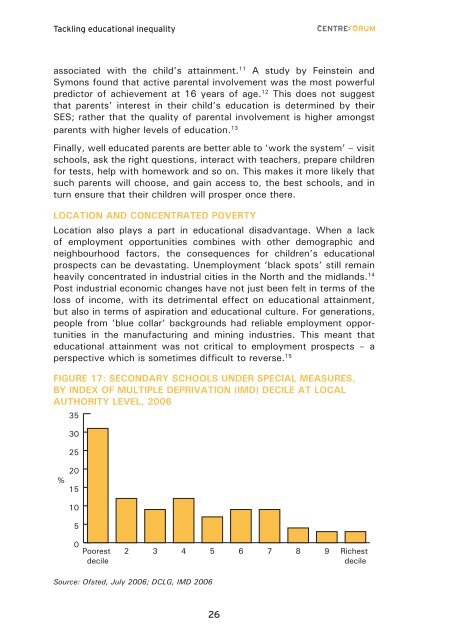Tackling educational inequality - CentreForum
Tackling educational inequality - CentreForum
Tackling educational inequality - CentreForum
Create successful ePaper yourself
Turn your PDF publications into a flip-book with our unique Google optimized e-Paper software.
<strong>Tackling</strong> <strong>educational</strong> <strong>inequality</strong><br />
associated with the child’s attainment. 11 A study by Feinstein and<br />
Symons found that active parental involvement was the most powerful<br />
predictor of achievement at 16 years of age. 12 This does not suggest<br />
that parents’ interest in their child’s education is determined by their<br />
SES; rather that the quality of parental involvement is higher amongst<br />
parents with higher levels of education. 13<br />
Finally, well educated parents are better able to ‘work the system’ – visit<br />
schools, ask the right questions, interact with teachers, prepare children<br />
for tests, help with homework and so on. This makes it more likely that<br />
such parents will choose, and gain access to, the best schools, and in<br />
turn ensure that their children will prosper once there.<br />
Location and concentrated poverty<br />
Location also plays a part in <strong>educational</strong> disadvantage. When a lack<br />
of employment opportunities combines with other demographic and<br />
neighbourhood factors, the consequences for children’s <strong>educational</strong><br />
prospects can be devastating. Unemployment ‘black spots’ still remain<br />
heavily concentrated in industrial cities in the North and the midlands. 14<br />
Post industrial economic changes have not just been felt in terms of the<br />
loss of income, with its detrimental effect on <strong>educational</strong> attainment,<br />
but also in terms of aspiration and <strong>educational</strong> culture. For generations,<br />
people from ’blue collar’ backgrounds had reliable employment opportunities<br />
in the manufacturing and mining industries. This meant that<br />
<strong>educational</strong> attainment was not critical to employment prospects – a<br />
perspective which is sometimes difficult to reverse. 15<br />
Figure 17: Secondary schools under special measures,<br />
by Index of Multiple Deprivation (IMD) decile at Local<br />
Authority level, 2006<br />
35<br />
30<br />
25<br />
20<br />
%<br />
15<br />
10<br />
5<br />
0<br />
Poorest<br />
decile<br />
2<br />
3<br />
4<br />
5<br />
6<br />
7<br />
8<br />
9<br />
Richest<br />
decile<br />
Source: Ofsted, July 2006; DCLG, IMD 2006<br />
26





